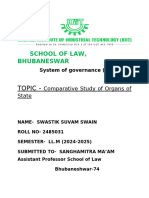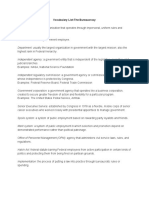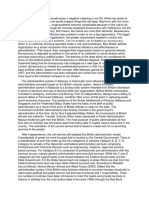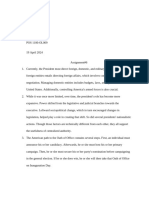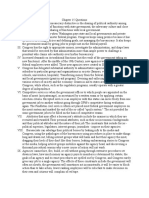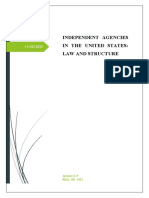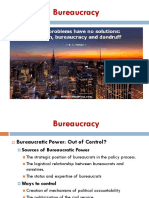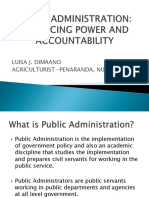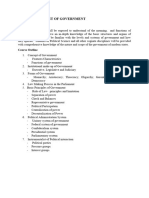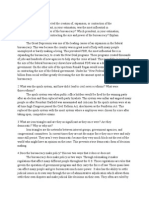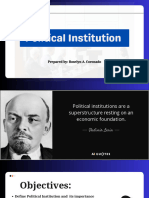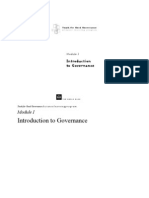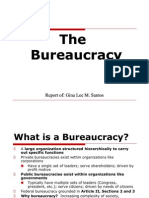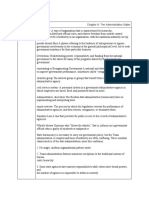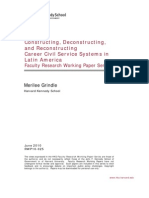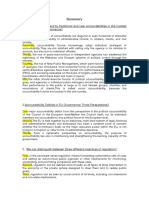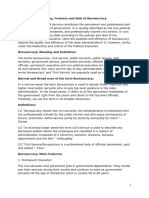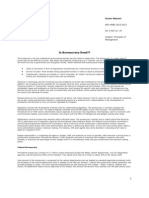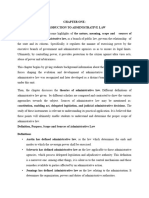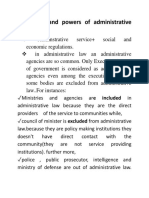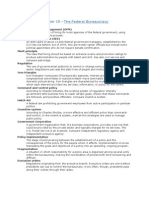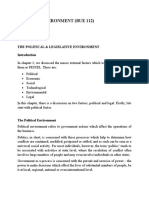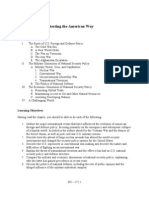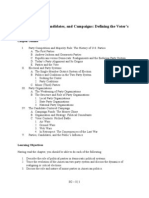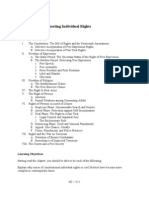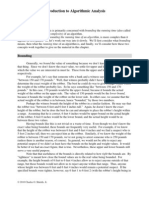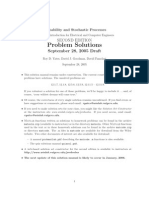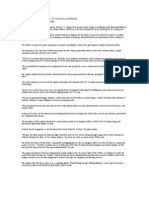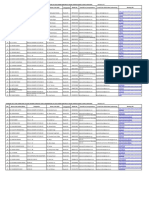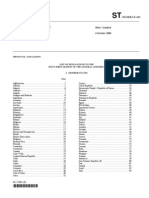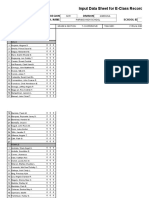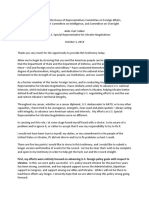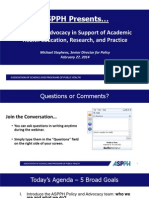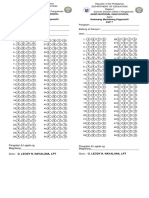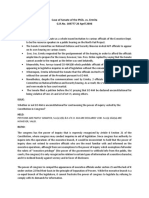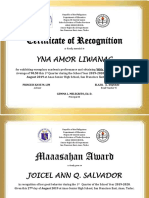Patterson10 SG Ch13
Patterson10 SG Ch13
Uploaded by
Kristin DikiciyanCopyright:
Available Formats
Patterson10 SG Ch13
Patterson10 SG Ch13
Uploaded by
Kristin DikiciyanOriginal Description:
Original Title
Copyright
Available Formats
Share this document
Did you find this document useful?
Is this content inappropriate?
Copyright:
Available Formats
Patterson10 SG Ch13
Patterson10 SG Ch13
Uploaded by
Kristin DikiciyanCopyright:
Available Formats
Chapter 13
The Federal Bureaucracy: Administering the Government
Chapter Outline I. Origin and Structure of the Federal Bureaucracy A. Types of Federal Agencies B. Federal Employment II. The Budgetary Process A. The President and Agency Budgets B. Congress and the Agency Budgets III. Policy and Power in the Bureaucracy A. The Agency Point of View B. Sources of Bureaucratic Power 1. The Power of Expertise 2. The Power of Clientele Groups 3. The Power of Friends in High Places IV. Democracy and Bureaucratic Accountability A. Accountability through the Presidency 1. Reorganization 2. Presidential Appointments 3. OMB: Budgets, Regulations, and Legislative Proposals B. Accountability through Congress C. Accountability through the Courts D. Accountability within the Bureaucracy Itself E. Senior Executive Service F. Administrative Law Judges G. Whistleblowing H. Demographic Representativeness Learning Objectives Having read the chapter, you should be able to do each of the following: . Describe the major functions and characteristics of the executive bureaucracy. . Identify the major types of organizations within the federal bureaucracy and provide examples of each type. . Contrast the patronage and merit systems and discuss the strengths and weaknesses of each system. . Comment on how the bureaucracy functions as a creative political agent and policymaker. . List some of the ways in which bureaucratic agencies are held accountable for their activities; evaluate the relative effectiveness of these measures.
SG 13 | 1
. Define and comment on the agency point of view; and describe the implications of this perspective on bureaucratic politics, policy making, and accountability. . Discuss the inherent conflict between bureaucratic power and democratic values. . Discuss the different methods through which the president may hold bureaucratic agencies accountable. . Describe how Congress and the courts exercise control over the bureaucracy and can force accountability both before and after laws are passed that give agencies authority. . Explain how the bureaucracy itself has attempted to increase its own effectiveness and accountability, including through initiatives such as the Senior Executive Service. Chapter Summary Bureaucracy is a method of organizing people and work, based on the principles of hierarchical authority, job specialization, and formalized rules. As a form of organization, bureaucracy is the most efficient means of getting people to work together on tasks of great magnitude and complexity. It is also a form of organization that is prone to waste and rigidity, which is why efforts are always being made to reform it. The United States could not be governed without a large federal bureaucracy. The day-to-day work of the federal government, from mail delivery to provision of social security to international diplomacy, is done by federal agencies. Federal employees work in roughly four hundred major agencies, including cabinet departments, independent agencies, regulatory agencies, government corporations, and presidential commissions. Yet the bureaucracy is more than simply an administrative giant. Administrators have discretion when making policy decisions. In the process of implementing policy, they make important policy and political choices. Administrators are actively engaged in politics and policymaking. The fragmentation of power and the pluralism of the American political system result in a contentious policy process, which leads government agencies to compete for power and resources. Accordingly, civil servants tend to have an agency point of view: they seek to advance their agencys programs and to repel attempts by others to weaken them. In promoting their agency, civil servants rely on their policy expertise, the backing of their clientele groups, and the support of the president and Congress. Administrators are not elected by the people they serve, yet they wield substantial independent power. Because of this, the bureaucracys accountability is a central issue. The major checks on the bureaucracy occur through the president, Congress, and the courts. The president has some power to reorganize the bureaucracy and the authority to appoint the political head of each agency. The president also has management tools (such as the executive budget) that can be used to limit administrators discretion. Congress has influence on bureaucratic agencies through its authorization and funding powers and through various devices (including enabling provisions, sunset provisions, and oversight hearings) that can increase administrators accountability. The judiciarys role in ensuring the bureaucracys accountability is smaller than that of the elected branches, but the courts have the authority to force agencies to act in accordance with legislative intent, established procedures, and constitutionally guaranteed rights. Internal checks on the
SG 13 | 2
bureaucracythe Senior Executive Service, administrative law judges, whistleblowing, and demographic representativenessare also mechanisms for holding the bureaucracy accountable. Focus and Main Points This chapter examines both the need for bureaucracy and the problems associated with it. The chapter describes the bureaucracys responsibilities, organizational structure, and management practices. The chapter also explains the politics of the bureaucracy. Although the three constitutional branches of government impose a degree of accountability on the bureaucracy, its sheer size confounds their efforts to control it fully. The main points discussed in this chapter are these: Bureaucracy is an inevitable consequence of complexity and scale. Modern government could not function without a large bureaucracy. Through authority, specialization, and rules, bureaucracy provides a means of managing thousands of tasks and employees. Bureaucrats naturally take an agency point of view, seeking to promote their agencys programs and power. They do this through their expert knowledge, support from clientele groups, and backing by Congress or the president. Although agencies are subject to oversight by the president, Congress, and the judiciary, bureaucrats exercise considerable power in their own right.
Major Concepts bureaucracy A system of organization and control based on the principles of hierarchical authority, job specialization, and formalized rules. hierarchical authority A basic principle of bureaucracy that refers to the chain of command within an organization whereby officials and units have control over those below them. job specialization A basic principle of bureaucracy holding that the responsibilities of each job position should be explicitly defined, and that a precise division of labor within the organization should be maintained. formalized rules A basic principle of bureaucracy that refers to the standardized procedures and established regulations by which a bureaucracy conducts its operations.
SG 13 | 3
cabinet (executive) departments The major administrative organizations within the federal executive bureaucracy, each of which is headed by a secretary or, in the case of Justice, the attorney general. Each department has responsibility for a major function of the federal government, such as defense, agriculture, or justice. independent agencies Bureaucratic agencies that are similar to cabinet departments but usually have a narrower area of responsibility. Each such agency is headed by a presidential appointee who is not a cabinet member. An example is the National Aeronautics and Space Administration. regulatory agencies Administrative units, such as the Federal Communications Commission and the Environmental Protection Agency, that have responsibility for the monitoring and regulation of ongoing economic activities. presidential commissions Advisory organizations within the bureaucracy that are headed by commissioners appointed by the president. An example is the Commission on Civil Rights. government corporations Government bodies, such as the U.S. Postal Service and Amtrak, that are similar to private corporations in that they charge for their services but differ in that they receive federal funding to help defray expenses. Their directors are appointed by the president with Senate approval. patronage system An approach to managing the bureaucracy whereby people are appointed to important government positions as a reward for political services they have rendered and because of their partisan loyalty. spoils system The practice of granting public office to individuals in return for political favors they have rendered. merit (civil service) system An approach to managing the bureaucracy whereby people are appointed to government positions on the basis of either competitive examinations or special qualifications, such as professional training. neutral competence The administrative objective of a merit-based bureaucracy. Such a bureaucracy should be competent in the sense that its employees are hired and retained on the basis of their expertise, and neutral in the sense that it operates by objective standards rather than partisan ones.
SG 13 | 4
budgetary process The process through which annual federal spending and revenue determinations are made. policy implementation The primary function of the bureaucracy; it refers to the process of carrying out the authoritative decisions of Congress, the president, and the courts. agency point of view The tendency of bureaucrats to place the interests of their agency ahead of other interests and ahead of the priorities sought by the president or Congress. clientele groups Special interest groups that benefit directly from the activities of a particular bureaucratic agency and therefore are strong advocates of the agency. bureaucratic accountability The degree to which bureaucrats are held accountable for the power they exercise. Senior Executive Service (SES) Top-level career civil servants who qualify through a competitive process to receive higher salaries than their peers but who can be assigned or transferred by order of the president. administrative law judge An official who presides at a trial-like administrative hearing to settle a dispute between an agency and someone adversely affected by a decision of that agency. whistleblowing An internal check on the bureaucracy whereby employees report instances of mismanagement that they observe. demographic representativeness The idea that the bureaucracy will be more responsive to the public if its employees at all levels are demographically representative of the population as a whole. Practice Exam (Answers appear at the end of this chapter.) Multiple Choice 1. The U.S. federal bureaucracy has about ________ employees. a. 1 million b. 1.5 million c. 2.5 million d. 4 million e. 6 million
SG 13 | 5
2. Which cabinet department currently has the largest budget in the United States? a. Education b. State c. Defense d. Treasury e. Health and Human Services 3. Which of the following is a regulatory agency? a. Central Intelligence Agency b. National Aeronautics and Space Administration c. Securities and Exchange Commission d. Environmental Protection Agency e. Both the SEC and the EPA are regulatory agencies. 4. ________ is the primary function of administrative agencies. a. Policy implementation b. Policy analysis c. The delivery of services d. Filing paperwork e. None of these answers is correct. 5. How did President Andrew Jackson change the bureaucracy? a. He increased the use of the merit system, such that nearly half of all federal administrative posts were filled through merit selection. b. He only gave jobs to social elites. c. He abused the patronage system, leading critics to call it the spoils system. d. He was the chief advocate of the patronage system. e. He created the merit system. 6. ________ created the merit, or civil service, system. a. The Hatch Act b. The Pendleton Act c. The Morrill Act d. The Progressive Act e. The Merit Protection Act 7. Administrative law judges a. are not officially empowered to administer oaths, seek evidence, or take testimony. b. usually hold their hearings in courtrooms. c. are generalists that maintain competency in the laws and regulations governing any major agency. d. are subject to performance or salary review by agency heads. e. typically work within the confines of a particular agency.
SG 13 | 6
8. Which of the following bureaucracies is currently the smallest, per capita, in the United States? a. Oklahoma state bureaucracy b. Montana state bureaucracy c. U.S. federal bureaucracy d. Hawaiian state bureaucracy e. Illinois state bureaucracy 9. A 2009 study of the SES found that a. the program has actually managed to increase agency loyalty and agency point of view among its top administrators. b. the program has been abused by Congress as a way to undermine presidential authority. c. the program has been very successful at reducing agency capture. d. most senior executives are assigned to work within their original agency. e. SES members have been passed over for promotion at a much greater rate than nonSES participants. 10. The Department of ________ is the newest cabinet department in the federal government. a. Homeland Security b. Veterans Affairs c. Education d. Energy e. Transportation 11. Which of the following statements is true? a. Bureaucrats make public policy. b. Bureaucrats implement the will of Congress. c. Bureaucrats are held accountable by federal courts. d. Bureaucrats engage in rulemaking. e. All these answers are correct. 12. During which of the following time periods did the federal bureaucracy experience the biggest spurt in its growth? a. 1830s b. 1870s c. 1930s d. 1990s e. All these answers are correct. 13. Which of the following is true of career bureaucrats? a. They tend to place the interests of Congress ahead of their agency. b. They tend to place the interests of the president ahead of their agency. c. They tend to place the public interest ahead of their agency. d. They tend to place the interests of their agency ahead of other interests. e. None of these answers is correct.
SG 13 | 7
14. The most substantial control that Congress exerts on the bureaucracy is through its power to a. pass laws. b. hire and fire federal judges. c. approve an agencys appointees. d. order audits of agency activities. e. decide how much money will be appropriated for agency programs. 15. Which of the following statements is true about whistleblowing? a. Many federal employees are reluctant to report instances of mismanagement because they fear it could harm their careers or reputations. b. Whistleblowers are protected by federal law against retaliation. c. Federal law provides whistleblowers with financial rewards in some cases. d. Whistleblowing sometimes does not occur until an employee has left an agency or quit government service entirely. e. All these answers are correct. 16. About ________ percent of managerial and professional positions in the federal bureaucracy are held by white males. a. 20 b. 33 c. 45 d. 60 e. 83 17. According to Charles Goodsell, the U.S. bureaucracy is a. very inefficient. b. the worst in the industrialized world. c. very inefficient; it is the worst in the industrialized world. d. among the best in the world. e. None of these answers is correct. 18. Which of the following is NOT one of the principles on which bureaucracy is based? a. hierarchical authority b. job specialization c. formalized rules d. patronage e. None of these answers is correct. 19. Independent agencies resemble the cabinet departments but typically have a. a smaller staff. b. a smaller budget. c. a wider area of responsibility. d. more autonomy from Congress. e. a narrower area of responsibility.
SG 13 | 8
20. All cabinet departments are headed by a secretary EXCEPT a. the Department of Defense. b. the Department of Housing and Urban Development. c. the Department of Health and Human Services. d. the Department of Justice. e. the Department of Homeland Security. True/False 1. The main effect of formalized rules within bureaucratic organizations is to create the red tape that gives bureaucrats their power over other political actors. a. True b. False 2. Hierarchy speeds bureaucratic decision-making by reducing conflict over the power to make decisions. a. True b. False 3. Federal employees are forbidden by law to join labor unions. a. True b. False 4. Independent agencies differ from executive departments in that they are not granted responsibility for specific policy areas. a. True b. False 5. Government corporations both charge their clients and receive federal funding to help defray operating expenses. a. True b. False 6. All federal government positions are filled according to merit-system criteria. a. True b. False 7. The SEC and EPA are examples of regulatory agencies. a. True b. False 8. Most bureaucratic agencies have an antagonistic relationship with the clientele that depend on the programs they run. a. True b. False
SG 13 | 9
9. President Kennedys Commission on Equal Employment Opportunity concluded that a demographically representative bureaucracy would be a more accountable one. a. True b. False 10. The agency point of view is characteristic of middle-rank civil servants but not highranking ones. a. True b. False Essay 1. Explain how administrators exercise discretion in carrying out their duties.
2.
What happened to the federal bureaucracy after the Pendleton Act was passed in 1883?
3.
Identify and explain the sources of bureaucratic power.
SG 13 | 10
4.
How do members of Congress hold bureaucrats accountable for their actions?
5.
Describe broadly the steps of the budget process.
Answers to the Practice Exam Multiple Choice Answers 1. c 2. e 3. e 4. a 5. d 6. b 7. e 8. c 9. d 10. a 11. e 12. c 13. d 14. e 15. e 16. d 17. d 18. d 19. e 20. d
Multiple Choice Explanations . There are roughly 2.5 million (c) full-time civilian employees of the federal government, who administer thousands of programs. The bureaucracy has more of an immediate impact on the daily lives of Americans than Congress or the president. . Health and Human Services (e) has the largest budget, and its activities account for more than a fourth of all federal spending.
SG 13 | 11
. The EPA and SEC (e) are regulatory agencies; the CIA and NASA are independent agencies. . The primary function of agencies is policy implementation (a), or carrying out decisions made by Congress, the president, and federal judges. . In the view of President Andrew Jackson, its chief advocate, the patronage system was a way to tie the administration of government to the people it served, so (d) is the correct response. . The merit system was created in 1883 with the passage of the Pendleton Act (b). . Administrative law judges typically work within the confines of a particular agency, and specialize in the laws and regulations governing its activities. Thus (e) is the correct answer. . On a per capita basis, the federal bureaucracy (c) is smaller than all of the state bureaucracies. . A 2009 study found that most senior executives are assigned to work within their original agency. The study concluded that most SES employees have been viewed primarily as agencyspecific assets, not federal or national assets. Thus, the answer is (d). . The newest department, the Department of Homeland Security (a), was created in 2002 in the aftermath of the terrorist attacks in 2001. . There are a multitude of tasks and experiences for officials in the executive bureaucracy, and (e) is the correct response. . The biggest spurt in the bureaucracys growth took place in the 1930s (c). Franklin D. Roosevelts New Deal included the creation of many new departments and agencies that grew the size of the bureaucracy immensely. . Administrators typically embrace the agency point of view, thus (d) is the correct answer. . The most substantial control that Congress exerts over the bureaucracy is through its power of the purse. Congress has constitutional authority over spending; it decides how much money will be appropriated for agency programs; thus, the answer is (e). . Whistleblowing is an infrequent activity, though whistleblowers are protected from retaliation. They are sometimes rewarded financially and sometimes wait until after leaving an agency to take action, therefore (e) is the correct answer. . The bureaucracy is not demographically representative at its top levels, and about 60 percent (d) of upper echelon jobs are held by white males. . Charles Goodsell argues that Americas bureaucracy is among the best in the world (d). . In formal terms, bureaucracy is a system of organization and control that is based on three principles: hierarchical authority, job specialization, and formalized rules. Although patronage is used in the U.S. system to fill some administrative posts, it is not a basic principle of bureaucracy. Thus, (d) is the correct response. . The correct answer is (e), as independent agencies resemble the cabinet departments but typically have a narrower area of responsibility. . The Attorney General heads the Department of Justice, which is the only department not headed by a secretary (d).
SG 13 | 12
True/False Answers 1. 2. 3. 4. 5. b a b b a 6. 7. 8. 9. 10. b a b a b
Essay Answers 1. Public administrators exercise a great deal of discretion in their jobs. They initiate, develop, and evaluate public policy. Bureaucrats do not simply administer policy, they make it as well. Many agencies have a very broad mandate that leaves room for interpretation by its administrators, and it is up to the bureaucrats to develop rules so that the law can be implemented. This is perhaps the chief manner in which administrators exercise power, and the process is known as rulemaking. During the course of their work, administrators may also develop policy ideas that they may then propose to the White House. 2. The Pendleton Act of 1883 established the civil serviceor meritsystem where certain federal employees were hired through competitive examinations or by virtue of having special qualifications, such as an advanced degree in a particular field. The transition to a professionalized civil service was gradual, however. Only 10 percent of federal positions in 1885 were filled on the basis of merit. This changed during the Progressive Era. The Progressives viewed the merit system as a way to eliminate party corruption and fraud in the administration of government. By 1920, the Progressive Era was ending, and more than 70 percent of federal employees were merit appointees. For the last half century, the proportion of merit employees at the federal level has never been below 80 percent. 3. The power of bureaucrats emanates from a number of sources, including their own expertise, the support of clientele groups that benefit from the programs they administer, and the backing of the president and Congress. Knowledge is power, and bureaucrats typically have much more expertise in their policy area than most others. By comparison, elected officials are generalists. Most agencies have clientele groups that benefit directly from the agencys programs. Bureaucrats can also seek positive relationships with the president and Congress; at times, congressional support is vital because the funding of agencies and programs is established through legislation. 4. The most substantial control that Congress exerts over the bureaucracy is through its power of the pursethe authority over the funding of programs. Without congressional authorization for funding, a program does not exist. Congress also exerts some influence over bureaucrats with its oversight function, which involves monitoring the bureaucracys work to ensure compliance with legislative intent. This oversight function is so massive and complex that Congress has turned over much of the responsibility for oversight to two support organizations, the Government Accountability Office (GAO) and the Congressional Budget Office (CBO). 5. The budgetary process begins with the president, who develops general budget guidelines that are then submitted to the executive departments and agencies. These entities produce detailed budgets, which are finalized by the OMB and submitted to the president. The president continues to work on the budget, making changes or additions, and then submits the budget to Congress in January. It goes first to the House and Senate budget committees, which recommend SG 13 | 13
overall spending levels, which are then approved by the full House and Senate. The budget is then further altered by the House and Senate appropriations committees, and again approved by each full body. These two versions are reconciled in conference committee and passed by both houses. The budget is then sent back to the president to be signed or vetoed.
SG 13 | 14
You might also like
- Checkpoint AnswersDocument28 pagesCheckpoint AnswersKristin Dikiciyan50% (4)
- CSS Public Administration NotesDocument29 pagesCSS Public Administration NotesZara Iftikhar78% (23)
- Rosenbloom Et Al, Chapter 1Document44 pagesRosenbloom Et Al, Chapter 1Dutu Sorin Iulian80% (5)
- Mendoza, Nelryan - Bpaoumn 1-2 - Chapter 2 To 14Document36 pagesMendoza, Nelryan - Bpaoumn 1-2 - Chapter 2 To 14NelRyan MendozaNo ratings yet
- Role of Bureaucracy in Developing CountrDocument19 pagesRole of Bureaucracy in Developing CountrMr. Biswajit Boruah -05No ratings yet
- Comparative Study of Organs of StateDocument11 pagesComparative Study of Organs of Statemiku11470No ratings yet
- Vocabularylist ThebureaucracyDocument2 pagesVocabularylist Thebureaucracyapi-331007250No ratings yet
- Final Government ExamDocument3 pagesFinal Government ExamratliffadysonNo ratings yet
- Weberian BureaucracyDocument4 pagesWeberian BureaucracyGabriel TayNo ratings yet
- Module 1 - Political Parties and Elections - EN PDFDocument31 pagesModule 1 - Political Parties and Elections - EN PDFMandukhaiTsogtbalNo ratings yet
- Written Assignment #6Document3 pagesWritten Assignment #6Sara RothenbergNo ratings yet
- My Pol 305 Assignment HamzatDocument11 pagesMy Pol 305 Assignment Hamzattilets.ekiti001No ratings yet
- Bureaucracy DefinedDocument5 pagesBureaucracy DefinedKent Alvin GuzmanNo ratings yet
- Chapter 15 Gov QuestionsDocument2 pagesChapter 15 Gov QuestionsseanhintonNo ratings yet
- Regulators ProjectDocument11 pagesRegulators ProjectAnjali K PNo ratings yet
- Balancing Values in The Administration of Public PolicyDocument29 pagesBalancing Values in The Administration of Public Policyاحمد صلاحNo ratings yet
- The Federal BureaucracyDocument30 pagesThe Federal BureaucracybobbynicholsNo ratings yet
- Bureauctratic PowerDocument15 pagesBureauctratic PowerpralavNo ratings yet
- Luisa J. Dimaano Agriculturist - Penaranda, Nueva EcijaDocument11 pagesLuisa J. Dimaano Agriculturist - Penaranda, Nueva EcijaMac ValdezNo ratings yet
- BureaucracyDocument7 pagesBureaucracyAstha ChhetriNo ratings yet
- POS 103 DescriptionDocument52 pagesPOS 103 Descriptionhm78q6fd4mNo ratings yet
- Major Players Bureaucracies in American GovernmentDocument5 pagesMajor Players Bureaucracies in American Governmenteleanor.kennedyNo ratings yet
- CH 9FederalBureaucracyQuestionsDocument3 pagesCH 9FederalBureaucracyQuestionsDylanNo ratings yet
- CompolgovDocument11 pagesCompolgovminyudumpNo ratings yet
- 4 Important Roles of Bureaucracy in Developing Countries Like IndiaDocument2 pages4 Important Roles of Bureaucracy in Developing Countries Like IndiaValmiki RahulNo ratings yet
- Role of Civil Services in A Democracy 1Document17 pagesRole of Civil Services in A Democracy 1Sarthak SouravNo ratings yet
- Administrative Law, The Legal Framework Within Which: Public Administration Justice GovernmentDocument5 pagesAdministrative Law, The Legal Framework Within Which: Public Administration Justice GovernmentSaffiNo ratings yet
- Module 3Document59 pagesModule 3mfoNo ratings yet
- BureaucraciesDocument21 pagesBureaucraciesbasumataryb176No ratings yet
- BureaucracyDocument14 pagesBureaucracySalah Uddin -74No ratings yet
- Rosenbloom, 1989, Ch.1Document44 pagesRosenbloom, 1989, Ch.1Andreea OpreaNo ratings yet
- Mod01 - Intro To GovernanceDocument7 pagesMod01 - Intro To GovernanceNisrina Nadhifah RahmanNo ratings yet
- Report TheoryDocument18 pagesReport TheoryGina Lee Mingrajal SantosNo ratings yet
- Chapter 8 GOVDocument6 pagesChapter 8 GOVAngela MartinezNo ratings yet
- Paper Merilee Grindle Servicio CivilDocument30 pagesPaper Merilee Grindle Servicio CivilpfaretNo ratings yet
- Unit ThreeDocument19 pagesUnit Threebeko dalechaNo ratings yet
- Public Administration Unit-66 Relationship Between Political and Permanent ExecutivesDocument11 pagesPublic Administration Unit-66 Relationship Between Political and Permanent ExecutivesDeepika Sharma80% (5)
- Summary of Contemporsry Issues of Public AdministrationDocument16 pagesSummary of Contemporsry Issues of Public AdministrationSajjad Ur RehmanNo ratings yet
- Public Administration Versus Business AdministrationDocument6 pagesPublic Administration Versus Business AdministrationHaseeb AliNo ratings yet
- Patterson10 SG Ch18Document14 pagesPatterson10 SG Ch18Kristin DikiciyanNo ratings yet
- Summery 11Document17 pagesSummery 11ramin momeniNo ratings yet
- Bureaucracy Meaning Features and Role ofDocument5 pagesBureaucracy Meaning Features and Role ofIsha MalikNo ratings yet
- Document 05 13 14 PDFDocument79 pagesDocument 05 13 14 PDFLiaa AquinoNo ratings yet
- Bureaucracy DeadDocument3 pagesBureaucracy DeadForam MasraniNo ratings yet
- Adminstrative Notes by Professor DawitDocument18 pagesAdminstrative Notes by Professor Dawitrekik tegeneNo ratings yet
- Chapter One and Two Admintrartive LawDocument23 pagesChapter One and Two Admintrartive LawhassanNo ratings yet
- Practical Principles For Public AdministrationDocument8 pagesPractical Principles For Public AdministrationLordy Villa Abrille100% (1)
- Adminstrative Note by DevaDocument27 pagesAdminstrative Note by Devarekik tegeneNo ratings yet
- Bureaucracy Ch.13Document5 pagesBureaucracy Ch.13jpatel28No ratings yet
- Key Terms: Chapter 15 - The Federal Bureaucracy: Office of Personnel Management (OPM)Document2 pagesKey Terms: Chapter 15 - The Federal Bureaucracy: Office of Personnel Management (OPM)scottNo ratings yet
- Administrative Law K-204Document18 pagesAdministrative Law K-204meenakshi kaurNo ratings yet
- BureaucracyDocument40 pagesBureaucracySwapnil PatilNo ratings yet
- Business Environment 2 PDF PDFDocument15 pagesBusiness Environment 2 PDF PDFDave NNo ratings yet
- Gec 3 Act. Yana NegadoDocument2 pagesGec 3 Act. Yana NegadoYana Xelca Mari NegadoNo ratings yet
- Academic Sessio1Document16 pagesAcademic Sessio1mohit rajNo ratings yet
- PAD 190 BureaucracyDocument20 pagesPAD 190 Bureaucracynsaid_31No ratings yet
- Nature and Scope of Administrative LawDocument9 pagesNature and Scope of Administrative LawManinderNo ratings yet
- 5 Features of Administrative LawDocument4 pages5 Features of Administrative LawLUCAS67% (3)
- The Seven Pillars of Democracy: A US Constitution JourneyFrom EverandThe Seven Pillars of Democracy: A US Constitution JourneyNo ratings yet
- Public Capitalism: The Political Authority of Corporate ExecutivesFrom EverandPublic Capitalism: The Political Authority of Corporate ExecutivesNo ratings yet
- Patterson10 SG Ch14Document16 pagesPatterson10 SG Ch14Kristin DikiciyanNo ratings yet
- Interest Groups: Organizing For Influence: Chapter OutlineDocument14 pagesInterest Groups: Organizing For Influence: Chapter OutlineKristin DikiciyanNo ratings yet
- Patterson10 SG Ch18Document14 pagesPatterson10 SG Ch18Kristin DikiciyanNo ratings yet
- Patterson10 SG Ch17Document13 pagesPatterson10 SG Ch17Kristin DikiciyanNo ratings yet
- Patterson10 SG Ch10Document14 pagesPatterson10 SG Ch10Kristin DikiciyanNo ratings yet
- The Presidency: Leading The Nation: Chapter OutlineDocument15 pagesThe Presidency: Leading The Nation: Chapter OutlineKristin Dikiciyan100% (1)
- Congress: Balancing National Goals and Local Interests: Chapter OutlineDocument16 pagesCongress: Balancing National Goals and Local Interests: Chapter OutlineKristin DikiciyanNo ratings yet
- Patterson10 SG Ch08Document16 pagesPatterson10 SG Ch08Kristin DikiciyanNo ratings yet
- Patterson10 SG Ch06Document13 pagesPatterson10 SG Ch06Kristin DikiciyanNo ratings yet
- Political Participation: Activating The Popular Will: Chapter OutlineDocument12 pagesPolitical Participation: Activating The Popular Will: Chapter OutlineKristin DikiciyanNo ratings yet
- Patterson10 SG Ch05Document14 pagesPatterson10 SG Ch05Kristin DikiciyanNo ratings yet
- Patterson10 SG Ch04Document15 pagesPatterson10 SG Ch04Kristin DikiciyanNo ratings yet
- Political Thinking: Becoming A Responsible Citizen: Chapter OutlineDocument14 pagesPolitical Thinking: Becoming A Responsible Citizen: Chapter OutlineKristin DikiciyanNo ratings yet
- Parallel ArraysDocument4 pagesParallel ArraysKristin DikiciyanNo ratings yet
- Solution ManualDocument30 pagesSolution ManualKristin Dikiciyan100% (1)
- HW 8 AnsDocument14 pagesHW 8 AnsKristin Dikiciyan100% (5)
- HW 06 SolnDocument19 pagesHW 06 SolnKristin Dikiciyan100% (1)
- Introduction To Algorithmic AnalysisDocument19 pagesIntroduction To Algorithmic AnalysisKristin DikiciyanNo ratings yet
- Sol ManualDocument443 pagesSol Manualgazalive100% (3)
- Sources LawDocument4 pagesSources LawJoey Villas MaputiNo ratings yet
- Trento West Central Elementary Sped Center: ST ND RDDocument1 pageTrento West Central Elementary Sped Center: ST ND RDBilly Ray Olid VinsonNo ratings yet
- Ecr Grade 7 U 3rd QDocument32 pagesEcr Grade 7 U 3rd QClarice TrasporteNo ratings yet
- State of Nation AddressDocument4 pagesState of Nation AddressgreyzelNo ratings yet
- Data Act - Congressional Letter - 2/2014Document2 pagesData Act - Congressional Letter - 2/2014Sunlight FoundationNo ratings yet
- Rouse AvenueDocument2 pagesRouse AvenueAshish GargNo ratings yet
- AP Gov CH 12Document24 pagesAP Gov CH 12a24dk100% (1)
- P R O G R A M M E Meeting de AvanceDocument2 pagesP R O G R A M M E Meeting de AvanceMichael Dominique Granada II100% (1)
- Answer To ComplaintDocument2 pagesAnswer To ComplaintDILG SAN NICOLAS PANGASINANNo ratings yet
- List of Delegations 61 2006 UN MpakogianniDocument167 pagesList of Delegations 61 2006 UN Mpakogianni24gr_info4093No ratings yet
- Berryessa Snow Mountain National Monument Expansion Act TextDocument7 pagesBerryessa Snow Mountain National Monument Expansion Act TextLakeCoNewsNo ratings yet
- Input Data Sheet For E-Class Record: Region Division School Name School IdDocument45 pagesInput Data Sheet For E-Class Record: Region Division School Name School IdAnimeLover ChannelNo ratings yet
- Division Memorandum On 2019 BE Best Implementing Schools Regional ValidationDocument2 pagesDivision Memorandum On 2019 BE Best Implementing Schools Regional ValidationmichelleNo ratings yet
- Full Statement From U.S. Ukraine Envoy Ambassador Kurt Volker On October 3, 2019Document11 pagesFull Statement From U.S. Ukraine Envoy Ambassador Kurt Volker On October 3, 2019The Federalist97% (106)
- Holmes TestimonyDocument213 pagesHolmes TestimonyNews Team100% (1)
- ASPPH Policy and AdvocacyDocument38 pagesASPPH Policy and Advocacykaja_a1No ratings yet
- TIGTA Final Response To Rep. LevinDocument5 pagesTIGTA Final Response To Rep. LevinPhilip BumpNo ratings yet
- Office of Special Counsel LetterDocument2 pagesOffice of Special Counsel Lettermglennonexaminer50% (2)
- From Comelec List of BeiDocument136 pagesFrom Comelec List of BeiRodnieGubatonNo ratings yet
- Tracking of Learners & Personnel FormDocument5 pagesTracking of Learners & Personnel FormG Andrilyn AlcantaraNo ratings yet
- The School Registrar Tinago National High School Tinago, Inopacan, LeyteDocument7 pagesThe School Registrar Tinago National High School Tinago, Inopacan, LeyteYbur Hermoso-MercurioNo ratings yet
- Bubble Answer SheetDocument1 pageBubble Answer SheetLeody Navaluna100% (1)
- Case of Senate of The Phils. vs. Ermita G.R.No. 169777 20 April 2006Document2 pagesCase of Senate of The Phils. vs. Ermita G.R.No. 169777 20 April 2006mmaNo ratings yet
- prc-2015-spl Pays Cir Memo 3572 DT 18-6-15Document3 pagesprc-2015-spl Pays Cir Memo 3572 DT 18-6-15api-215249734No ratings yet
- 2008-10-02 Ad Cessna 172Document9 pages2008-10-02 Ad Cessna 172Elmer VillegasNo ratings yet
- 2017 2018 PROJECT AN AND 4fs FormsDocument3 pages2017 2018 PROJECT AN AND 4fs FormsDaaarls100% (2)
- Certificate of Recognition: Yna Amor LiwanagDocument13 pagesCertificate of Recognition: Yna Amor LiwanagGlaiza Dalayoan FloresNo ratings yet
- Pandi v. CA DigestDocument2 pagesPandi v. CA Digestcmv mendoza100% (2)
- UrgentAdvisory BARCOSimultaneousDocument4 pagesUrgentAdvisory BARCOSimultaneousJhan DamandamanNo ratings yet
- Annual Learning Action Cell (Lac) Plan SY 2019-2020: Schools Division Office of PampangaDocument2 pagesAnnual Learning Action Cell (Lac) Plan SY 2019-2020: Schools Division Office of PampangaAmanda Vitug Espinoza100% (1)





